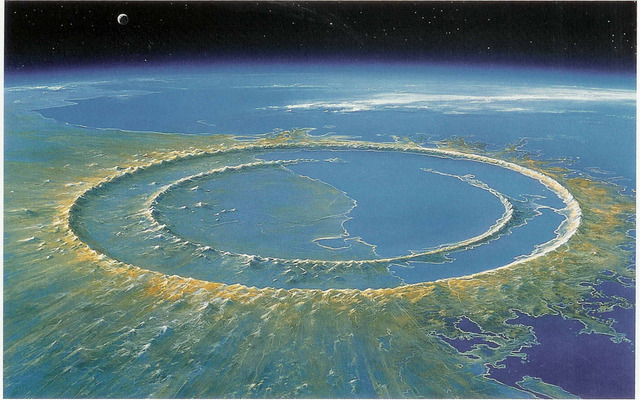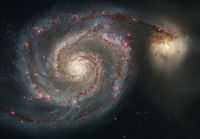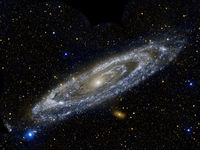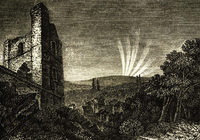2007年08月06日
天文(8)-隕石孔(2)

Sudbury Basin is the oval structure.

NASA World Wind satellite image of the Sudbury astrobleme.
(旧暦 6月24日)
天文(7)-隕石孔(1)のつづき
現在、地球上の隕石の衝突痕と考えられているものの中で、次の3つのクレーターが巨大で有名です。
1. フレデフォート・ドーム(Vredefort dome) 南アフリカ共和国 直径300㎞
2. サドベリー隕石孔(Sudbury Basin) カナダ・オンタリオ州 直径約250㎞
3. チクシュルーブ・クレーター(Chicxulub Crater) ユカタン半島 直径約180km
第2位 サドベリー隕石孔(Sudbury Basin) カナダ・オンタリオ州 直径約250㎞
サドベリー隕石孔(Sudbury Basin)は、現在は長径62㎞、短径30㎞、深さ15㎞の隕石孔で、約18億5千万年前の古原生代(Paleoproterozoic)に約10㎞の隕石の衝突により形成され、隕石孔の最初の大きさは約250㎞程度であったと考えられています。
衝突時のエネルギーは、TNT火薬に換算して80Tt (テラトン: 1兆トン、80兆トンは、広島型原爆が15Kt程度なので、広島型原爆の50億倍) 以上にのぼると推定されています。
しかし、その後に起きたカナダ盾状地の造山運動であるグレンヴィル造山運動(the Grenville orogeny)により、約10億年前に南東から圧縮力を受け現在のような楕円形の形状になったというものです。
サドベリー構造(the Sudbury structure)は、1964年にアリゾナ州立大学地質学教室のRobert Sinclair Dietz (1914~1995) 教授が隕石説を提唱するまでは、カナダ盾状地に対する大規模な火成岩の貫入によると考えられていたため、サドベリー貫入岩体(The Sudbury Igneous Complex)とも呼ばれています。
サドベリー隕石孔はまた、ニッケル・銅硫化物鉱床を含む1100平方kmに及ぶ鉱山群で、サドベリーのニッケルは年間世界生産の7割を占めていた時期もあったようです。
第3位 チクシュルーブ・クレーター(Chicxulub Crater) ユカタン半島 直径約180km

Radar topography reveals the 180 kilometer (112 mile) wide ring of the crater .
1978年、メキシコ湾沿岸で石油採掘を進めていたメキシコ石油公社のスタッフは、ユカタン半島の北部で奇妙な環状陥没構造を見つけました。飛行機による重力分布測定(石油発掘のための地質調査)の結果、重力異常の分布によってチクシュルーブ(Chicxulub)の町を中心として直径180kmのクレーターが海底に埋まっていると推定されました。
これこそが、今では恐竜類やアンモナイトなど地球上の動植物の75%以上が絶滅したとされる小惑星の衝突の痕跡とされる、チクシュルーブ・クレーター(Chicxulub Crater)です。
The meteorite's estimated size was about 10 km in diameter, releasing an estimated 500 zettajoules (5.0×10^23 joules) of energy, approximately 100 teratons of TNT (10^14 tons), on impact. By contrast, the most powerful man-made explosive device ever detonated, the Tsar Bomba or Emperor Bomb, had a yield of only 50 megatons, which would make this impact 2,000,000 times more powerful.
The impact would have caused some of the largest megatsunamis in Earth's history. These would have spread in all directions, hitting the Caribbean island of Cuba especially hard. A cloud of dust, ash and steam would spread itself from the crater. The pieces of the meteorite would have rained all over Earth, igniting global wildfires. The shock waves would have continued hundreds of kilometers into the planet, causing global earthquakes and volcanic eruptions. The emission of dust and particles covered the entire surface of the earth for several years, possibly a decade, creating a harsh environment. (Pope, et al., 1997) by Wikpedia.
参考資料
Bralower, Timothy J.; Charles K. Paull and R. Mark Leckie (1998).
"The Cretaceous-Tertiary boundary cocktail: Chicxulub impact triggers margin collapse and extensive sediment gravity flows".
(http://www.geosc.psu.edu/people/faculty/personalpages/tbralower/Braloweretal1998.pdf)
おしまい

Radar topography reveals the 180 kilometer (112 mile) wide ring of the crater .
1978年、メキシコ湾沿岸で石油採掘を進めていたメキシコ石油公社のスタッフは、ユカタン半島の北部で奇妙な環状陥没構造を見つけました。飛行機による重力分布測定(石油発掘のための地質調査)の結果、重力異常の分布によってチクシュルーブ(Chicxulub)の町を中心として直径180kmのクレーターが海底に埋まっていると推定されました。
これこそが、今では恐竜類やアンモナイトなど地球上の動植物の75%以上が絶滅したとされる小惑星の衝突の痕跡とされる、チクシュルーブ・クレーター(Chicxulub Crater)です。
The meteorite's estimated size was about 10 km in diameter, releasing an estimated 500 zettajoules (5.0×10^23 joules) of energy, approximately 100 teratons of TNT (10^14 tons), on impact. By contrast, the most powerful man-made explosive device ever detonated, the Tsar Bomba or Emperor Bomb, had a yield of only 50 megatons, which would make this impact 2,000,000 times more powerful.
The impact would have caused some of the largest megatsunamis in Earth's history. These would have spread in all directions, hitting the Caribbean island of Cuba especially hard. A cloud of dust, ash and steam would spread itself from the crater. The pieces of the meteorite would have rained all over Earth, igniting global wildfires. The shock waves would have continued hundreds of kilometers into the planet, causing global earthquakes and volcanic eruptions. The emission of dust and particles covered the entire surface of the earth for several years, possibly a decade, creating a harsh environment. (Pope, et al., 1997) by Wikpedia.
参考資料
Bralower, Timothy J.; Charles K. Paull and R. Mark Leckie (1998).
"The Cretaceous-Tertiary boundary cocktail: Chicxulub impact triggers margin collapse and extensive sediment gravity flows".
(http://www.geosc.psu.edu/people/faculty/personalpages/tbralower/Braloweretal1998.pdf)
おしまい
※このブログではブログの持ち主が承認した後、コメントが反映される設定です。









